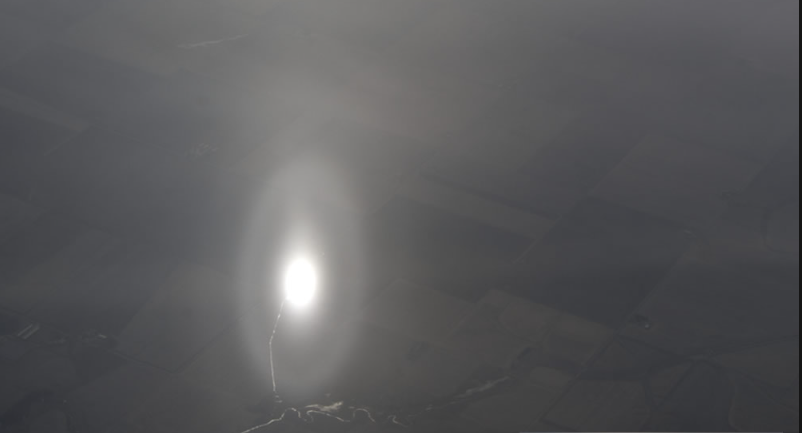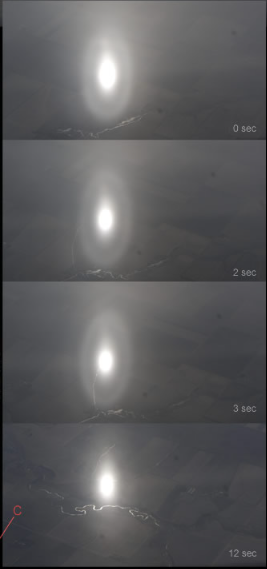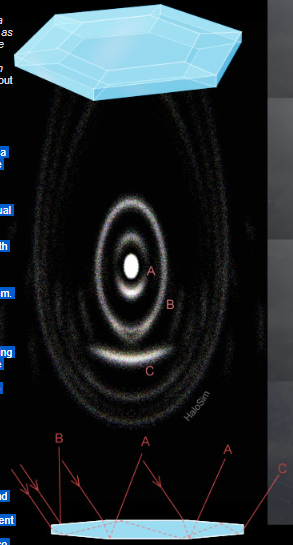Bottlinger's Rings
Bottlinger's Rings: A Rare Atmospheric Phenomenon
Bottlinger's Rings, a captivating atmospheric optics phenomenon, are a sight to behold. These delicate and shimmering ovals that form around the subsun are a rare occurrence, lasting only a few seconds at most. While subsuns, the blindingly bright reflections of sunlight from flat-plate ice crystals in altocumulus clouds, are relatively common beneath aircraft, Bottlinger's Rings add an extra layer of enchantment to the spectacle.
The Elusive Nature of Bottlinger's Rings
Captured by photographer Tim Stone during a flight over Northwest Illinois on March 23, 2010, Bottlinger's Rings are a peculiar sight. Stone described witnessing a brilliant subsun and noticed a ring developing around it as he took pictures. These ephemeral rings appeared in three of his frames before disappearing as the cloud bank moved out of view.
The Mysterious Formation of Bottlinger's Rings
The exact mechanisms behind the formation of Bottlinger's Rings remain poorly understood. It is believed that pyramidal ice crystals with slight slopes ranging from 1-3° may play a role in their creation. These rings are thought to be related to the small elliptical halos sometimes observed around the sun.
Unraveling the Intricacies of Bottlinger's Rings
To gain further insight into the formation of Bottlinger's Rings, scientists have employed ray tracing simulations. These simulations involve considering various parameters such as crystal tilts, face aspect ratios, and central prism thickness. However, even after several iterations, significant improvements in matching the simulations to the observed images are challenging to achieve. This suggests that there may be deficiencies in the current model used to explain Bottlinger's Rings.
Crystal Orientation and Alignment
One fascinating aspect of Bottlinger's Rings is their dependence on precisely oriented ice crystals. These crystals must have minimal horizontal wobbling to create the distinctive rings. Achieving such alignment among large dendritic crystals in clouds poses a significant challenge, raising questions about the viability of this explanation.
Exploring the Connection with Subparhelia
If you happen to spot Bottlinger's Rings, it is worth keeping an eye out for subparhelia as well. Subparhelia are additional atmospheric phenomena that may accompany Bottlinger's Rings. These unexpected shapes and patterns add an element of surprise and intrigue to the overall spectacle.
The Quest for a Deeper Understanding
While Bottlinger's Rings continue to captivate observers, there is still much to learn about their formation and underlying mechanisms. Scientists and photographers alike are driven by curiosity to unravel the mysteries of these ethereal ovals. Through ongoing research, further insights into the intricacies of atmospheric optics may be gained, shedding light on the enigmatic world above us.
Note: This article has been automatically converted from the old site and may not appear as intended. You can find the original article here.

Bottlinger's Rings ~ Tim Stone (Tim's Pix) pictured this very rare sight from 32,000 ft over Northwest Illinois March 23, 2010.
“.. I was (of course) watching for atoptics, and saw a brilliant subsun. That's actually not too unusual, but as I was taking pictures a ring developed around it. The ring appears in three of my frames .right.. As that particular cloud bank fell behind us, the subsun then resumed its usual appearance.” All images are without enhancement from the original camera RAW files.
©Tim Stone, shown with permission.


A subsun is a familiar sight beneath an aircraft. It is a blindingly bright reflection sunlight from flat-plate ice crystals in altocumulus cloud.
This is different. Bottlinger’s rings - delicate and shimmering ovals around the subsun - are an unusual sighting. They are ephemeral and might last for no more than a few seconds. Tim’s images show two main rings 3.1 and 5.4° across their narrow axes with less distinct glows.
Bottlinger’s rings are poorly understood. Pyramidal crystals with sides sloping only 1-3° might make them. The rings are probably related to the small elliptical halos sometimes seen around the sun.
The HaloSim ray tracing is for the sun elevation of ~31° and uses the crystal at top right. The second ring B is from direct mirroring by the pyramid facets. The inner ring A comes from internal reflections. Quite surprising ray routes generate bright patches above and below the subsun.
Unlike above horizon elliptical halos, subsun Bottlinger’s rings require precisely oriented crystals with no more than small wobbles from horizontal.
The simulation might better match the images after more adjustment of parameters like the tilts of the upper and lower pyramids, the face aspect ratios and the central prism thickness. Maybe! After a while, further iterations rarely lead to significant improvement leading to the suspicion that the basic model is deficient. The required pyramid slope angles are also quite unphysical. To get over the latter objection, the outer dendrite extensions of snowflakes have been invoked to account for the necessary gently tilted faces. But then it is hard to see how large dendritic crystals could be so well aligned in clouds.
Back to observation - If you see Bottlinger rings, search for subparhelia - their shapes might just be a surprise.
Note: this article has been automatically converted from the old site and may not appear as intended. You can find the original article here.
Reference Atmospheric Optics
If you use any of the definitions, information, or data presented on Atmospheric Optics, please copy the link or reference below to properly credit us as the reference source. Thank you!
-
<a href="https://atoptics.co.uk/blog/bottlingers-rings/">Bottlinger's Rings</a>
-
"Bottlinger's Rings". Atmospheric Optics. Accessed on April 28, 2024. https://atoptics.co.uk/blog/bottlingers-rings/.
-
"Bottlinger's Rings". Atmospheric Optics, https://atoptics.co.uk/blog/bottlingers-rings/. Accessed 28 April, 2024
-
Bottlinger's Rings. Atmospheric Optics. Retrieved from https://atoptics.co.uk/blog/bottlingers-rings/.